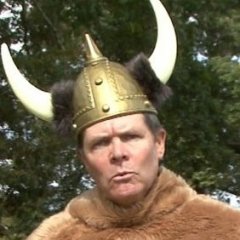Skeletal Golf Operation Techniques
At Rockbottum CC, our green fee for a weekday walker is $10. We don’t get very many walking players, but if someone wanted to play several times a week, it would be affordable.
The fees go up for riders, but the amount is still minimal when compared to other courses in our area, especially the clubs that went millions in debt to attract new members with upgraded clubhouse facilities.
Rockbottum CC doesn’t have the slick shine of our expensive neighbors, but we have one thing they don’t: Play. Lots of play.
. . . we have one thing they don’t: Play. Lots of play.
Rockbottum CC operates on very low overhead and makes no attempt to compete with the fine country clubs or the CCFAD courses. Rockbottum CC inhabits a strange niche market, sort of a cross between entry level golfers and players tired of making the equivalent of a house payment just to play golf.
The low overhead means rugged conditions, leaves, irregular maintenance and inconsistent grooming standards. (Gasp) But it also means $10 walking.
There are no houses, the fairways are twice the width of any course within crow-flyin’ distance, the architecture is retro-throwback cherry-picked from several eras and the greens are UD Muda. Some of the greens are over 12,000 square feet with movement impossible to achieve on superfast surfaces.
. . . the architecture is retro-throwback cherry-picked from several eras and the greens are UD Muda.
It is a business. The method of operation that allows Rockbottum CC to thrive in hard economic times is called Skeletal Golf Management, or in our shorthand: “Skeletal Greenkeeper.”
The Skeletal Greenkeeper is only possible here because we do not have a Board, a Committee, a GM, a Pro or a membership making demands based on tournament conditions they have witnessed on TV. Nor do we have any members that violate the 14-Club Rule. (That’s where a member belongs to more than 14 clubs, plays each one on Member-Guest Day and develops highly irrational expectations.)
Skeletal Golf Management looks for extremely inexpensive ways to operate the golf course, not just in payroll and equipment, but in conditioning the golfer to accept lowered standards. (This is usually done by pointing to the $10 fee on the ancient menu board in the dark, smoky pro shop, devoid of assistant pros, bag boys or any other remnant of the cult of customer service.)
Rockbottum’s Pro Shop has a screen door that slams, hound dogs that lounge about on the cart fleet and no signs turning away folks wearing cargo shorts. When the former members of fine clubs make their first appearance at Rockbottum CC, they are often outraged, shocked and disgusted by the smoky clubhouse, the hounds and the golfers clothed in deer hunting garb warming up on the range. But after a few visits, they assimilate into the culture and bring others along.
When the recently converted to Skeletal Golf players are questioned by the potential converts, regarding the poor dress code, the lack of bowing and scraping by clubhouse staff . . . and the hounds stealing hot dogs from the cart, the new veterans simply answer, “Hey, 10 dollar golf.”
Hey, 10 dollar golf.
The down side to Skeletal Golf involves the never ending search for cheaper ways to operate, to minimize costs and yet still maintain playability. Sometimes, we find techniques that allow for huge cuts in operational budgets. Sometimes, the method just doesn’t work out.
Here’s a Skeletal Greenkeeper method we are currently fine-tuning to reduce our inventory of turf vehicles:



0 Comments
Recommended Comments
There are no comments to display.